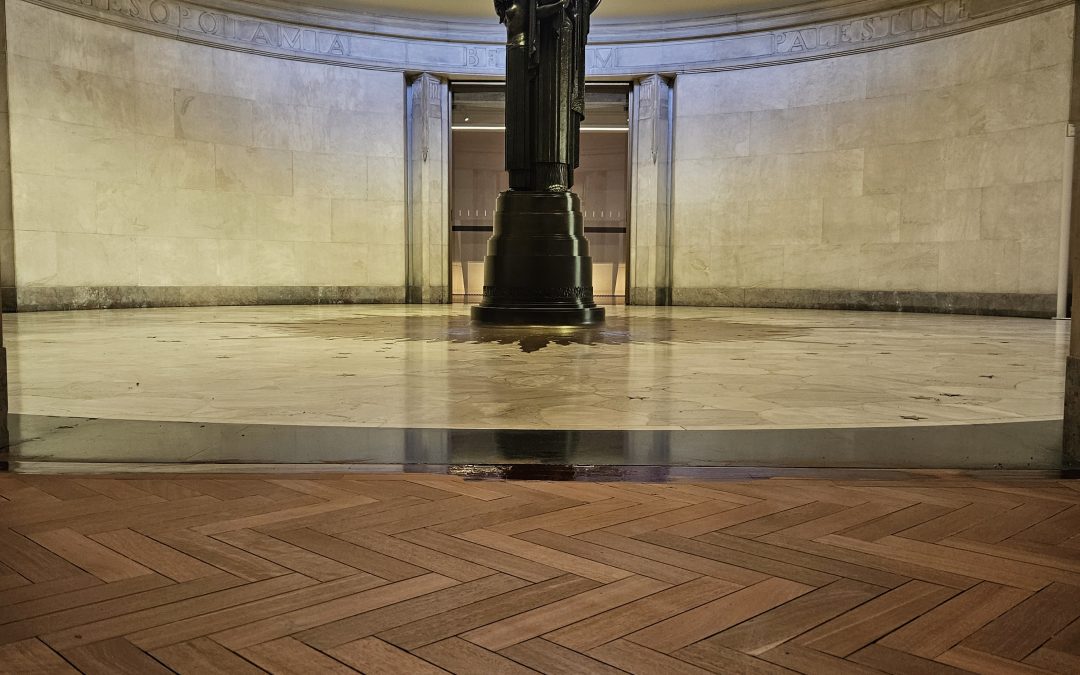Parquetry Restorations in Sydney’s ANZAC Hyde Park War Memorial, 2024.
The Hyde Park ANZAC (Australian and New Zealand Army Corps) War Memorial, situated in the City of Sydney New South Wales, stands as a lasting tribute to the sacrifices made by Australian and New Zealand servicemen and women during various conflicts. The memorial itself holds immense significance to Australian history and culture.
Constructed in 1934, the Hyde Park War Memorial serves as a solemn reminder of the impact of war on our nation.
The memorial’s location in the very heart of Sydney city shows its extreme importance to our forefathers. It is a focal point for commemorative events and ceremonies.
It stands at the central position in Hyde Park, a place of beauty and enjoyment for many. And its location ensures that the memory of those who served and sacrificed is not confined to history books but remains an integral part of the Sydney city experience.
The memorial commemorates various conflicts in which Australian and New Zealanders played a crucial role, including World War I, World War II, the Korean War, and subsequent conflicts. The inscriptions on the memorial list the names of servicemen and women who made the ultimate sacrifice, creating a tangible link between the past and the present. There is a small museum, sculptures, areas of quiet reflection, and the tomb of the unknown soldier.
It was with a view to all this significance that we approached the restoration of an original Jarrah Herringbone Parquetry floor, located in the staff offices section, which is not open to the public.
The door we entered though to do this work has a sign above. It says:
Limbless Soldiers association NSW
Services canteens trust fund
United returned Soldiers Fund
TB Sailors, Soldiers and Airmen’s Assoc NSW
Throughout, I tried to be in reverence. Protection of this particular flooring became a spiritual experience, as I imagined the returned servicemen who would have walked through that door, and straight onto this floor. The main repair was a difficult situation, and many would have pulled half the hallway up. I judged that to be sympathetic to the historical value will mean to try to do a cosmetic repair and not take it too far, given the section was located in the mid of a long hallway.
I nicknamed the repair the technically difficult hallway repair. A repair of this type, in a location in the floor such as this, I would never usually attempt, due to the nature of the interlocking block and the risk of making the whole thing look worse.
My protocol with Heritage Parquetry repairs is to replace blocks only when absolutely necessary, as the colour, installation method and appearance will be different than the surrounding flooring.
As we sanded away the accumulated oil, dirt and dust, we discovered an incredibly beautiful work of art, a work of art that many generations had used, and many to come can walk on and pay respect.
The people that walked through that door in the past, and into the future, may not even notice the floor or imagine who walked on it, but all will pay respect to our forefathers who died in conflict, and those who remain.
The job was broken into three stages, stage one is as follows:
Jarrah Herringbone T&G Parquetry with a border detail: was sympathetically repaired using two types of repairs, invasive and non-invasive:
- Flooring in the mid hallway presented as twisted off its 45 degree alignment, and as a result was subject to individual block movement and large moving gaps between the blocks.
- The flooring was pushed into a better alignment. Placing jarrah strips parallel into the border detail created a positive pressure that enabled some gaps to reduce. The alignment was improved, but not fully corrected due to the nature of the repair situation and its location.
- We removed and replaced a number of blocks into the centre of the repair area, to improve the visual appearance and reduce the largest gaps.
- We filled with an epoxy filler some damaged and gapped blocks.
- We have sealed the floor with multiple coats of modified Tung oil Seal, chosen due to the dry time and reduced Odour and improved wear resistance over time.
- There is a couple of white Jarrah blocks contained in the border detail, which we left for examination, we will wood stain these to suit, and yet they are Jarrah, part of the younger part of the tree.
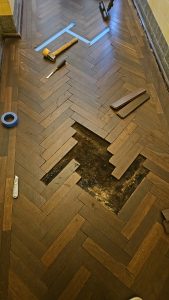
Heritage parquetry repair
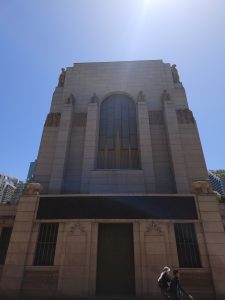
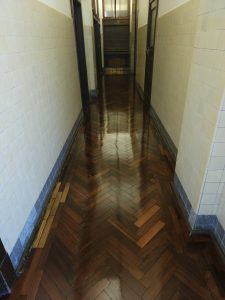
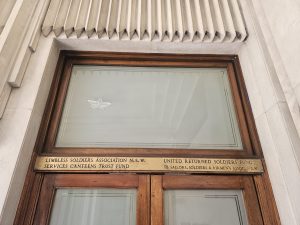
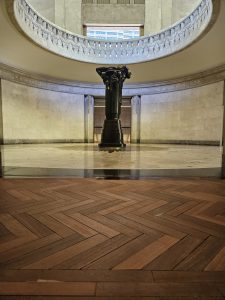
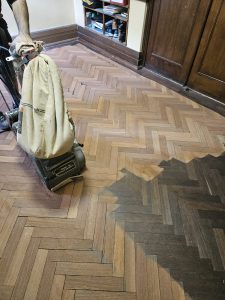
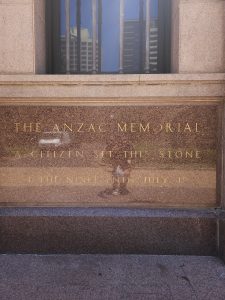
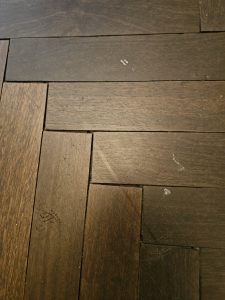
The reason for the repair work into the hallway: The border detail in this repair area (three block brick bond, parallel with wall) on the eastern side, weakened and slowly shifted further into the wall, moving the repair area of about 3-4M2 of herringbone pattern around and making the floor loose and out of alignment.
Overall, the rest of the floor presents as an excellent surviving example of a Hardwood Jarrah Parquetry floor installed in the 1930s.
Working at night, we experienced some of the interesting situations the security staff have to deal with.
There is a security guard on the outside of the building 24 hours a day. Working on a Friday night, we got to hear some stories. Two young lads were arrested the previous night, they climbed the stairs and damaged some artifacts.
Hyde Park itself is a lovely place to have a picnic, walk in the evening, sit and chat with friends. Visitors often come to pay their respects, lay wreaths, and participate in ceremonies that honour the memory of those who served their country.
In conclusion, the Hyde Park War Memorial in Sydney, NSW, holds significant importance as a physical artifact of Australia’s commitment to remembering and honouring the sacrifices of its servicemen and women. Beyond its architectural importance, the memorial serves as a spiritual focal point for reflection, education, and collective remembrance, ensuring that the lessons of the past are not forgotten and that the spirit of gratitude endures for generations to come.
We appreciated and respected the opportunity to do this work on a historical and cultural landmark in Sydney. Given the sensitive nature of the premises, we proceeded our work with reverence and care.
Do you have any heritage flooring stories to tell? Let us know!
Ivan Kirton,
We Love Parquet

